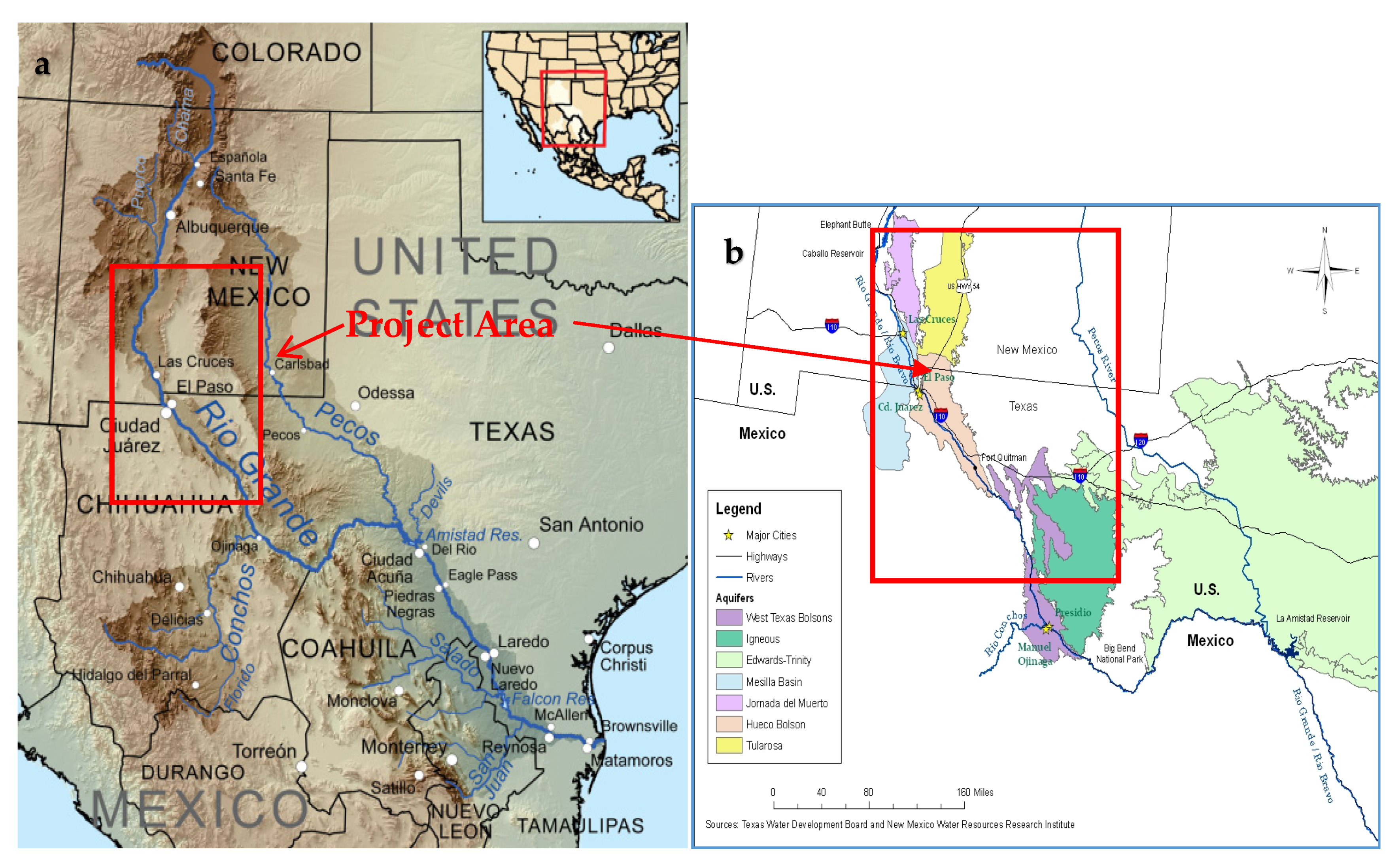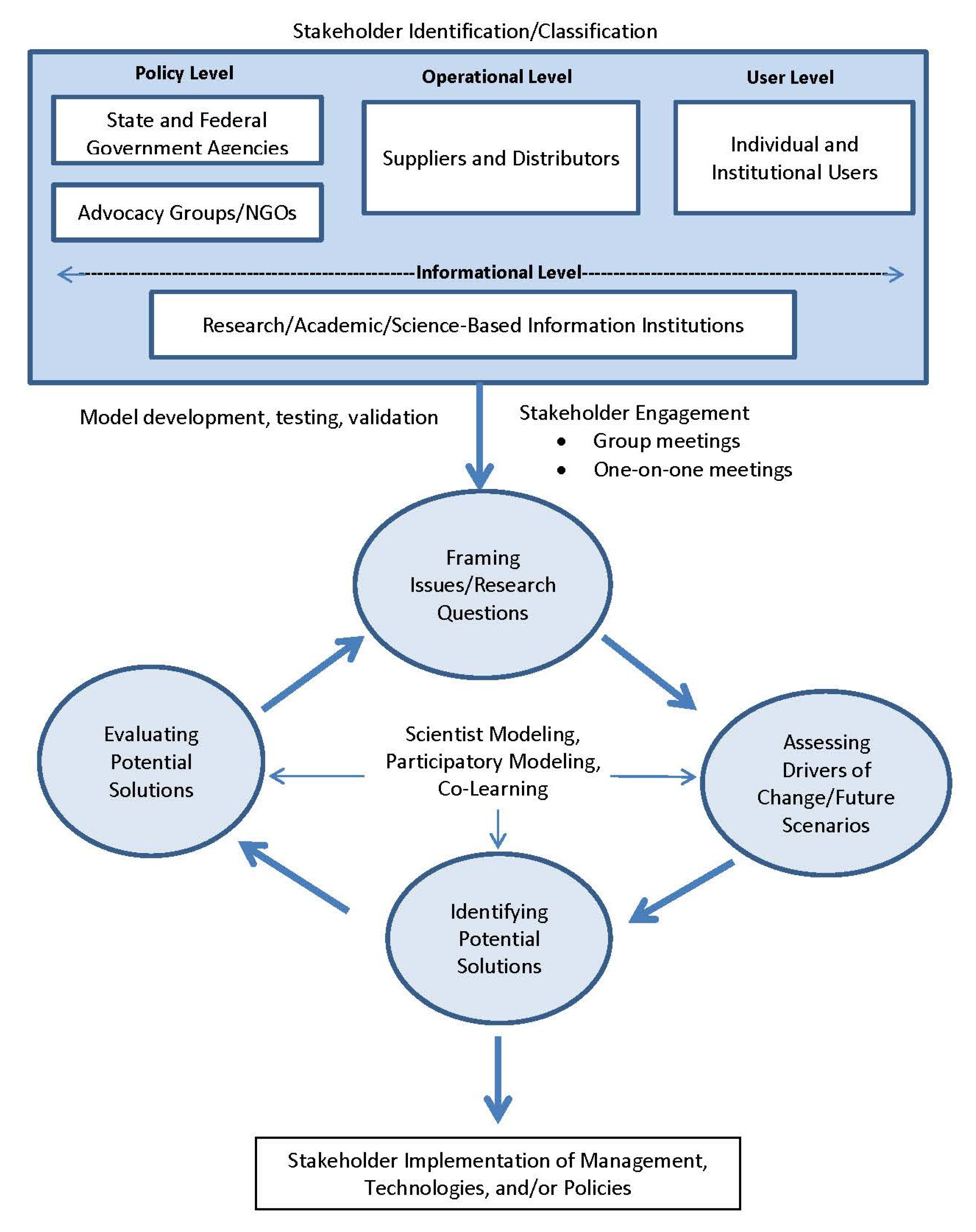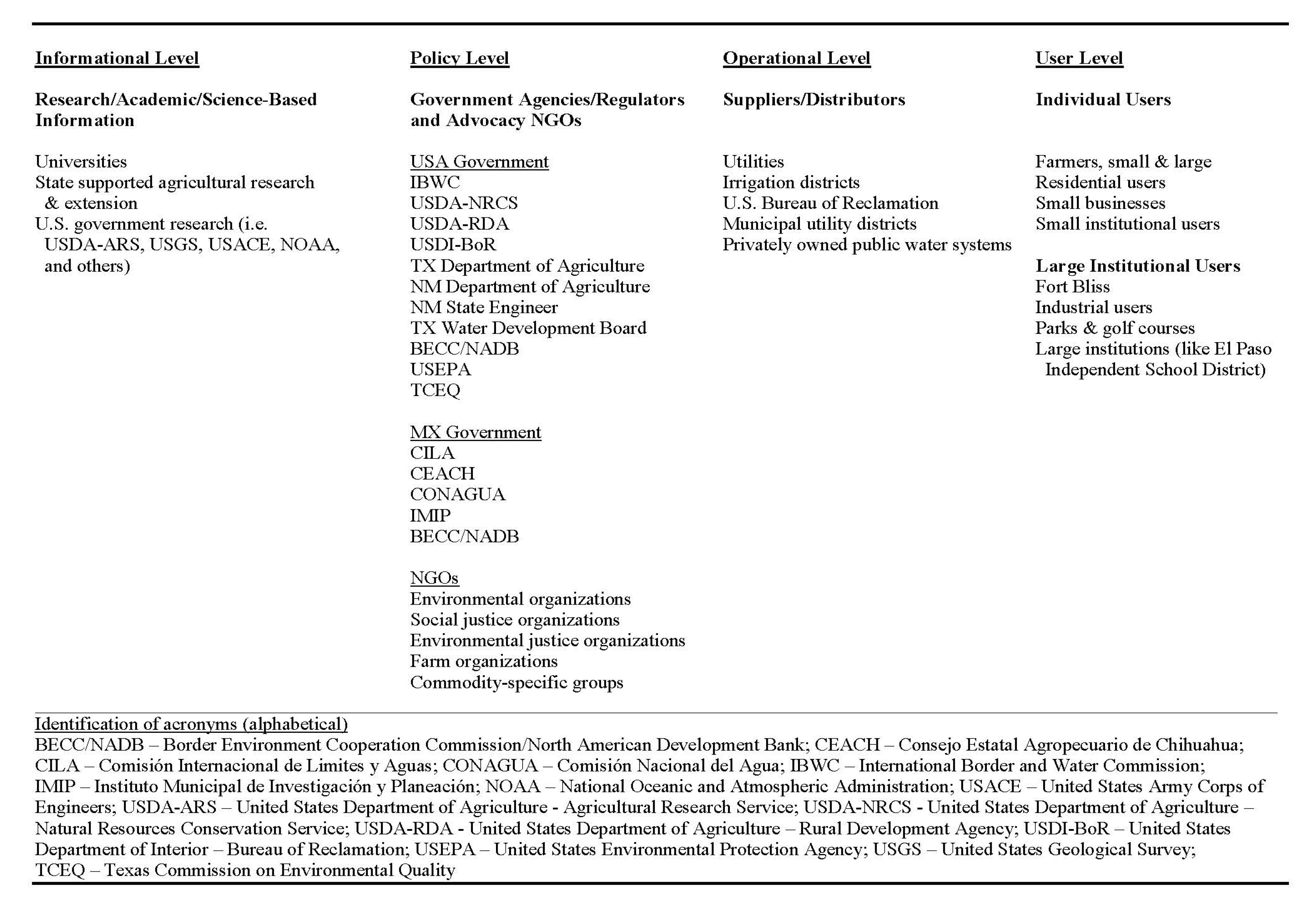A Comprehensive Process for Stakeholder Identification and Engagement in Addressing Wicked Water Resources Problems
Abstract
1. Introduction
2. Literature Review: Stakeholder Engagement
3. Materials and Methods
3.1. Case Study Description
3.2. Theoretical Framework for Stakeholder Engagement
3.3. Stakeholder Identification and Classification
3.4. Stakeholder Engagement: Vision, Challenges, and Research Questions
- Name, in one word, your biggest concern about the future of water in our region.
- What questions would you like to ask about the future of water?
- What future scenarios would you like to explore, both for water supply and water demand?
- What issues or processes are important to consider in our models?
- To help you think about (visualize) the future of water, what information (data, model predictions/output) would you want to know?
- What time horizon concerns you?
- Other issues/concerns?
3.5. Model Validation/Verification
4. Results
4.1. Stakeholder Engagement: Diverse Participation
4.2. Framing Issues and Identifying Research Questions: Commonalities
4.3. Framing Issues and Identifying Research Questions: Divergent Views
5. Discussion
5.1. Sources of Tension and Conflict
5.1.1. Agriculture–Urban
5.1.2. Environment–Agriculture–Urban
5.1.3. Social Justice–Agriculture–Urban
5.2. The Wicked Problem of Sustainable Water Resources Management in the Middle Rio Grande
5.2.1. The Spiral of Climate Change, Prolonged Drought, Groundwater Depletion, and Salinization
5.2.2. Agricultural Intensification, Urbanization, and Conjunctive Management
5.2.3. The Complexity and Obsolescence of the Water Governance Framework
5.2.4. Land Ownership, Water rights, and Threats
5.3. Stakeholder Engagement: Lessons Learned Regarding Best Practices and Pitfalls
- Relevant stakeholders need to be analyzed and represented systematically.
- Participation should be considered as early as possible and throughout the process.
- Clear objectives for stakeholder participation need to be established from the beginning, and the process should be transparent to all participants.
- At least some, if not all, modeling tools should be accessible and useable by all.
- Scientists should approach the project with humility.
- Stakeholders should be valued for their contributions.
5.3.1. Be Respectful of Stakeholders’ Views, Time, and Confidence/Trust
5.3.2. Be Clear about Expectations
5.3.3. Identify What Stakeholders Want to Get Out of It and Try to Deliver
6. Conclusions
Author Contributions
Funding
Conflicts of Interest
References
- Rittel, H.; Webber, M. Dilemmas in a general theory of planning. Policy Sci. 1973, 4, 155–169. [Google Scholar] [CrossRef]
- Liebman, J. Some simple-minded observations on the role of optimization in public systems decision-making. Interfaces 1976, 6, 102–108. [Google Scholar] [CrossRef]
- Freeman, D.M. Wicked water problems: Sociology and local water organizations in addressing water resources policy. J. Am. Water Res. Assoc. 2000, 36, 483–491. [Google Scholar] [CrossRef]
- Gallagher, D.R. Chapter 1. Why Environmental Leadership? In Environmental Leadership: A Reference Handbook; Gallagher, D.R., Ed.; SAGE Publications: Thousand Oaks, CA, USA, 2012; pp. 3–10. [Google Scholar] [CrossRef]
- Hargrove, W.L.; Borrok, D.M.; Heyman, J.M.; Tweedie, C.W.; Ferregut, C. Water, climate, and social change in a fragile landscape. Ecosphere 2013, 4, 1–13. [Google Scholar] [CrossRef]
- Gutzler, D.S. Regional climatic considerations for borderlands sustainability. Ecosphere 2013, 4, 11–12. [Google Scholar] [CrossRef]
- Hogan, J.F. Water quantity and quality challenges from Elephant Butte to Amistad. Ecosphere 2013, 4, 1–16. [Google Scholar] [CrossRef]
- Sheng, Z. Impacts of groundwater pumping and climate variability on groundwater availability in the Rio Grande Basin. Ecosphere 2013, 4, 1–25. [Google Scholar] [CrossRef]
- Reed, P.M.; Kasprzyk, J. Water resources management: The myth, the wicked, and the future. J. Water Resour. Plan. Manag. 2009, 135, 411–413. [Google Scholar] [CrossRef]
- Brugnach, M.; Ingram, H. Ambiguity: The challenge of knowing and deciding together. Environ. Sci. Policy 2012, 15, 60–71. [Google Scholar] [CrossRef]
- Rhoades, R.E.; Booth, R.H. Farmer-Back-to-Farmer: A Model for Generating Acceptable Agricultural Technology. Agric. Adm. 1982, 11, 127–137. [Google Scholar] [CrossRef]
- Van den Belt, M. Mediated Modeling. A System Dynamics Approach to Environmental Consensus Building; Island Press: Washington, DC, USA, 2004; p. 339. [Google Scholar]
- Fraternali, P.; Castelletti, A.; Soncini-Sessa, R.; Vaca Ruiz, C.; Rizzoli, A.E. Putting humans in the loop: Social computing for water resources management. Environ. Model. Softw. 2012, 37, 68–77. [Google Scholar] [CrossRef]
- Gaddis, E.J.B.; Falk, H.H.; Ginger, C.; Voinov, A. Effectiveness of a participatory modeling effort to identify and advance community water resource goals in St. Albans, Vermont. Environ. Model. Softw. 2010, 25, 1428–1438. [Google Scholar] [CrossRef]
- Kelly, R.A.; Jakeman, A.J.; Barreteau, O.; Borsuk, M.E.; ElSawah, S.; Hamilton, S.H.; Henriksen, H.J.; Kuikka, S.; Maier, H.R.; Rizzoli, A.E.; et al. Selecting among five common modelling approaches for integrated environmental assessment and management. Environ. Model. Softw. 2013, 47, 159–181. [Google Scholar] [CrossRef]
- Reed, M.S. Stakeholder participation for environmental management: A literature review. Biol. Conserv. 2008, 141, 2417–2431. [Google Scholar] [CrossRef]
- Robles-Morua, A.; Halvorsen, K.E.; Mayer, A.S.; Vivoni, E.R. Exploring the application of participatory modeling approaches in the Sonora River Basin, Mexico. Environ. Model. Softw. 2014, 52, 273–282. [Google Scholar] [CrossRef]
- Hurd, B.H. Climate Vulnerability and Adaptive Strategies along the Rio Grande/Rio Bravo Border of Mexico and the United States. J. Contemp. Water Res. Educ. 2012, 149, 56–63. [Google Scholar] [CrossRef]
- Scott, C.A.; Buechler, S.J. Iterative driver-response dynamics of human-environment interactions in the Arizona-Sonora borderlands. Ecosphere 2013, 4, 2. [Google Scholar] [CrossRef]
- Browning-Aiken, A.; Morehouse, B.J. Social-Ecological Resilience of Transboundary Watershed Management: Institutional Design and Social Learning. In Transboundary Water Resources Management: A Multidisciplinary Approach; Ganoulis, J., Aureli, A., Fried, J.J., Eds.; Wiley-VCH: Weinheim, Germany, 2011; pp. 275–280. [Google Scholar]
- Cai, X.; Lasdon, L.; Michelsen, A. Group decision making in water resources planning using multiple objective analysis. J. Water Resour. Plan. Manag. 2004, 130, 4–14. [Google Scholar] [CrossRef]
- Megdal, S.B.; Eden, S.; Shamir, E. Water governance, stakeholder engagement, and sustainable water resources management. Water 2016, 8, 190. [Google Scholar] [CrossRef]
- Kallis, G.; Videira, N.; Antunes, P.; Guimaraes Pereira, A.G.; Spash, C.L.; Coccossis, H.; Corral Quintana, S.; del Moral, L.; Hatzilacou, D.; Lobo, G.; et al. Participatory methods for water resources planning. Environ. Plan. C Gov. Policy 2006, 24, 215–234. [Google Scholar] [CrossRef]
- Basco-Carrera, L.; van Beek, E.; Jonoski, A.; Benitez-Avila, C.; Guntoro, F.P. Collaborative modeling for informed decision making and inclusive water development. Water Res. Manag. 2017, 31, 2611–2625. [Google Scholar] [CrossRef]
- Subramanian, A.; Brown, B.; Wolf, A.T. Understanding and overcoming risks to cooperation along transboundary rivers. Water Policy 2014, 16, 824–843. [Google Scholar] [CrossRef]
- Akhmouch, A.; Clavreul, D. Stakeholder engagement for inclusive water governance: “Practicing what we preach” with the OECD water governance initiative. Water 2016, 8, 204. [Google Scholar] [CrossRef]
- Tidwell, V.C.; Passell, H.D.; Conrad, S.H.; Thomas, R.P. System dynamics modeling for community-based water planning: Application to the Middle Rio Grande. Aquatic Sci. 2004, 66, 357–372. [Google Scholar] [CrossRef]
- Sandoval-Solis, S.; Rebecca, L.; Teasley, D.C.; McKinney, G.A. Thomas, and Carlos Patiño-Gomez. J. Am. Water Res. Assoc. 2013, 49, 639–653. [Google Scholar] [CrossRef]
- Eden, S.; Megdal, S.B.; Shamir, E.; Chief, K.; Lacroix, K.M. Opening the black box: Using a hydrological model to link stakeholder engagement with groundwater management. Water 2016, 8, 216. [Google Scholar] [CrossRef]
- Lund, J.R.; Palme, R.N. Water resource system modeling for conflict resolution. Water Resour. Update 1997, 3, 70–82. Available online: http://www.ecs.umass.edu/waterresources/papers/papers/Lund-and-Palmer (accessed on 1 January 2019).
- Stave, K. A system dynamics model to facilitate public understanding of water management options in Las Vegas, Nevada. J. Environ. Manag. 2003, 67, 303–313. [Google Scholar] [CrossRef]
- Kallenberger, J.; Waskom, R.; Smith, M.; Sternlieb, F.; Taylor, P.; Megdal, S.; Bright, A.; Knight, R.; Pritchett, J.; Laituri, M.; et al. Understanding beliefs and references of irrigators towards the use and management of agricultural water in the Colorado River Basin. Report of Ag Water User Survey Results. 2013, p. 22. Available online: www.CRBagwater.colostate.edu (accessed on 1 January 2019).
- Lacroix, K.E.M.; Megdal, S.B. Explore, synthesize, and repeat: Unraveling complex water management issues through the stakeholder engagement wheel. Water 2016, 8, 118. [Google Scholar] [CrossRef]
- King, A.B.; Thornton, M. Staying the course: Collaborative modeling to support adaptive and resilient water resource governance in the Inland Northwest. Water 2016, 8, 232. [Google Scholar] [CrossRef]
- Feldman, D.; Ingram, H. Climate forecast, water management, and knowledge networks: Making science useful to decision makers. Water Clim. Soc. 2009, 1, 9–21. [Google Scholar] [CrossRef]
- Ingram, H. Beyond universal remedies for good water governance: A political and contextual approach. In Water for Food in a Changing World; Garrido, A., Ingram, H., Eds.; Routledge/Taylor/Francis Books: Oxford, UK; New York, NY, USA, 2011; pp. 241–261. [Google Scholar]
- Castle, S.L.; Thomas, B.F.; Reager, J.T.; Rodell, M.; Swenson, S.C.; Famigliatti, J.S. Groundwater depletion during drought threatens future water security of the Colorado River Basin. Geophys. Res. Lett. 2014. [Google Scholar] [CrossRef] [PubMed]
- Hargrove, W.L.; Devlin, D. The road to clean water: Building collaboration and stakeholder relationships. J. Soil Water Conserv. 2010, 65, 104A–110A. [Google Scholar] [CrossRef]
- Heyman, J.; Mayer, A.; Hargrove, W.; Granados, A.; Pennington, D. Lifetimes for a Trans-Boundary Aquifer: Drivers of Change and Proposals for Response. In Proceedings of the Chapman Conference on the Quest for Sustainability of Heavily Stressed Aquifers at Regional to Global Scales, Valencia, Spain, 21–24 October 2019. [Google Scholar]
- Ward, F.A.; Mayer, A.S.; Garnica, L.A.; Townsend, N.T.; Gutzler, D.S. The economics of aquifer protection plans under climate-water stress: New insights from hydroeconomic modeling. J. Hydrol. 2019, 576, 667–684. [Google Scholar] [CrossRef]
- Villanueva-Rosales, N.; Chavira, L.G.; Tamrakar, S.R.; Pennington, D.; Vargas-Acosta, R.A.; Ward, F.; Mayer, A.S. Capturing scientific knowledge for water resources sustainability in the Rio Grande area. In Proceedings of the Second International Workshop on Capturing Scientific Knowledge, Austin, TX, USA, 4 December 2017; Garijo, D., de Vos, M., Eds.; Association for Computing Machinery: New York, NY, USA. [Google Scholar]
- Ahn, S.; Abudu, S.; Sheng, Z.; Mirchi, A. Hydrologic Impacts of Drought-adaptive Agricultural Water Management in a Semi-arid River Basin: Case of Rincon Valley, New Mexico. Agric. Water Manag. 2018, 209, 206–218. [Google Scholar] [CrossRef]
- Samimi, M.; Tahneen Jahan, N.; Mirchi, A. Assessment of climate change impacts on surface water hydrologic processes in New Mexico-Texas-Mexico border region. In Proceedings of the World Environmental and Water Resources Congress: Protecting and Securing Water and the Environment for Future Generations, Minneapolis, MN, USA, 3–7 June 2018; American Society of Civil Engineers: Reston, VA, USA, 2018. [Google Scholar]
- Borrok, D.M.; Engle, M.A. The role of climate in increasing salt loads in dryland rivers. J. Arid Environ. 2014, 111, 7–13. [Google Scholar] [CrossRef]
- Aeschbach-Hertig, W.; Gleeson, T. Regional strategies for the accelerating global problem of groundwater depletion. Nat. Geosci. 2012, 5, 853–861. [Google Scholar] [CrossRef]
- Gleeson, T.; Wada, Y.; Bierkens, M.F.P.; van Beek, L.P.H. Water balance of global aquifers revealed by groundwater footprint. Nature 2012, 488, 197–200. [Google Scholar] [CrossRef]
- Bernstein, S.; Cashore, B.; Levin, K.; Auld, G. Playing it forward: Path dependency, Progressive incrementalism, and the “super wicked” problem of global climate change. In Proceedings of the International Studies Association 48th Annual Convention, Chicago, IL, USA, 28 February–3 March 2007. [Google Scholar]
- Langsdale, S.; Beall, A.; Bourget, E.; Hagen, E.; Kudlas, S.; Palmer, R.; Tate, D.; Werick, W. Collaborative modeling for decision support in water resources: Principles and best practices. J. Am. Water Res. Assoc. 2013, 49, 629–638. [Google Scholar] [CrossRef]
- Voinov, A.; Bousquet, F. Modelling with stakeholders. Environ. Model. Softw. 2010, 25, 1268–1281. [Google Scholar] [CrossRef]
- Martínez-Santos, P.; Henriksen, H.J.; Zorrilla, P.; Martínez-Alfaro, P.E. Comparative reflections on the use of modelling tools in conflictive water management settings: The Mancha Occidental aquifer, Spain. Environ. Model. Softw. 2010, 25, 1439–1449. [Google Scholar] [CrossRef]
- Beall, A.; Fiedler, F.; Boll, J.; Cosens, B. Sustainable water resource management and participatory system dynamics. Case Study: Developing the Palouse Basin Participatory Model. Sustainability 2011, 3, 720–742. [Google Scholar] [CrossRef]
- Cash, D.; Clark, W.C.; Alcock, F.; Dickson, N.M.; Eckley, N.; Jäger, J. Salience, Credibility, Legitimacy and Boundaries: Linking Research, Assessment and Decision Making. KSG Working Papers Series. 2003. Available online: http://nrs.harvard.edu/urn-:HUL.InstRepos:32067415 (accessed on 1 January 2019).
- Giordano, R.; Brugnach, M.; Pluchinotta, I. Ambiguity in problem framing as a barrier to collective actions: Some hints from groundwater protection policy in the Apulia Region. Group Decis. Negot. 2017, 26, 911–932. [Google Scholar] [CrossRef]



| Question | Most Common Responses from Multiple Sectors |
|---|---|
| 1. Summarize in one word your biggest concern about the future of water in our region. | Quantity Quality Drought Urbanization Conservation Sustainability Scarcity |
| 2. What questions would you like to ask about the future of water? | Impacts of climate change? What will it take to get more conservation? Future water supplies and sources? Binational management? Value of water? What are the limits to pumping groundwater? |
| 3. What future scenarios would you like to explore/evaluate? | Augmented supplies Transboundary/binational management |
| 4. What issues or processes are important for us to consider in our models? | Salinization Surface/groundwater interactions |
| 5. To visualize or think about the future of water, what information (data, model predictions, output) would you want to know? | Better weather information Medium and long-term climate projections Prediction of drought Surface/groundwater interactions |
| 6. What time horizon interests you? | Varied widely with no consensus, but generally in the range of 20–50 years |
| 7. Other issues/concerns? | Lack of public understanding of water issues and: value of agriculture, value of technology, value of ecosystem services, social justice |
| Short Question | Agriculture | Urban | Government | Environment | Social Justice |
|---|---|---|---|---|---|
| #1 - Word | Quantity Quality Drought Urbanization | Knowledge Education Understanding | Climate change | Climate change Ecosystems Habitat Wetlands | Access Supply |
| #2 - Questions about the future of water? | Urbanization Drought & its effect on groundwater Quality Limits of pumping Augmenting supply: importation, desalination, stormwater capture How to manage under scarcity | New policy approaches What is it going to take to conserve? Cost/behavior relationship Binational water management? | What do we have now? Optimal allocation of water Value of water/water footprint | Sources What will ensure consideration of environment? Value of water | Water quality Groundwater decline Future supplies Fracking impacts |
| #3- Future scenarios you would like to evaluate | Urbanization Alternative crops Value of water and economic impact on food/value chain Augmenting supply: desalination, importation, etc. | Prolonged drought Climate change Binational water treatment and expanded water reuse Binational economic impacts | Model droughts beyond the drought of record Management under scarcity Demand projections Limits to pecan production Strategies for no/limited water | How to connect water to ecotourism Define what is needed for environmental services | The limits to “digging deeper” Cost – how high? Uncontrolled growth |
| #4 - Issues or processes to be considered | Salinization Regional weather/climate | What is the sustainable water withdrawal rate? | What do we know already? Changes in water quality Value of ecotourism | Climate change Urbanization Benefits of natural systems Natural flows | |
| #5- To visualize future, what info do you need? | Management above Elephant Butte What are the supply limits Adaptability of crops to salinity Better assessment of groundwater Water demand by cities Recharge | What are the consequences of no action/no change Sustainable groundwater withdrawal rate | Impact of surface water on groundwater | No pecans scenario Impacts of urbanization | Current situation? Baseline Contaminants in groundwater Public health |
| #6 – Time horizon of interest? | Older farmers – now MX farmers – 5/15 All others 20/50/100 | 5/10/20/50 | 5/20/50 | Short-term and 100 yrs | 5/30/50 |
© 2020 by the authors. Licensee MDPI, Basel, Switzerland. This article is an open access article distributed under the terms and conditions of the Creative Commons Attribution (CC BY) license (http://creativecommons.org/licenses/by/4.0/).
Share and Cite
Hargrove, W.L.; Heyman, J.M. A Comprehensive Process for Stakeholder Identification and Engagement in Addressing Wicked Water Resources Problems. Land 2020, 9, 119. https://doi.org/10.3390/land9040119
Hargrove WL, Heyman JM. A Comprehensive Process for Stakeholder Identification and Engagement in Addressing Wicked Water Resources Problems. Land. 2020; 9(4):119. https://doi.org/10.3390/land9040119
Chicago/Turabian StyleHargrove, William L., and Josiah M. Heyman. 2020. "A Comprehensive Process for Stakeholder Identification and Engagement in Addressing Wicked Water Resources Problems" Land 9, no. 4: 119. https://doi.org/10.3390/land9040119
APA StyleHargrove, W. L., & Heyman, J. M. (2020). A Comprehensive Process for Stakeholder Identification and Engagement in Addressing Wicked Water Resources Problems. Land, 9(4), 119. https://doi.org/10.3390/land9040119





